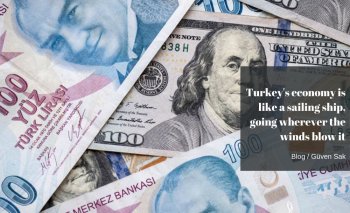TEPAV Articles
- [Archive]
Being a top ten economy: are we dreaming? 14/11/2011 - Viewed 2854 times
On a TV show recently, the program host was wandering through the streets of a rising Anatolian city, asking people how many weeks there were in a year. The majority of the respondents answered, “4 times 12, so 48 weeks,” while others took guesses like 8, 25 or 50. Even more upsetting was that some who tried to get to the answer by multiplying 4 and 12 failed to solve this simple multiplication problem and blurred out numbers like 46, 45, or 49. These were young university students. What got to me the most however, was that two young primary school teachers confidently responded “54 weeks.”
It appears that Turkey’s education system fails to teach people that there are 52 weeks (365 days and 6 hours) in a year. If the vox populi is anything to go by, we lack basic skills like multiplication and addition. Faced with this reality, I was left wondering how Turkey can change shape and join the top-ten economies of the world by 2023, as the governing AKP promises. The question does, in fact, come to me whenever I read the front pages of the newspapers these days. I’d recommend you also put on your development economist spectacles every once in a while, and ask yourself “is this also the case in the top ten economies of the world?” This can be anything from labor productivity to the buildings that collapsed during an earthquake or prosecution durations.
The below table can be used to roughly compare Turkey to the rest of the world. It gives us a sense of the top twenty economies of the world on the basis of five fundamental indicators. Turkey ranks seventeenth in terms of gross national product, given in the first column. The following columns show the average age of the population, output per worker (productivity level), average years of schooling, and the female labor force participation rate. It answers the questions “where do we rank?” and “what should we look like?”
Below are the brief conclusions I have drawn:
- To begin with, we can exclude countries with populations much greater than that of Turkey, like the USA, China, Brazil and India. After all, we aim to prosper not by increasing the population, but by increasing the per capita income level. Countries in the top ten with populations similar to that of Turkey, among which are Japan, Germany, France, the UK, Italy and Canada, must be included in the comparison. Note that Turkey has to replace one of these countries to enter the top ten by 2023. Countries which are not among the top ten but have populations similar to that of Turkey, such as Poland, Korea, Mexico and Spain, must also be involved. Who knows, maybe one or more of them will outpace Turkey and make it to the top ten.
- The second column gives us some good news. Turkey’s population is much younger than those of the top ten. You have probably heard of this before. The majority of the countries Turkey has to compete with have aging populations. For example, the average Spanish, Polish or Korean citizen is ten years older than the average Turkish citizen. On the other hand, Mexico and Brazil enjoy the same advantage as Turkey. In short, most Turks won’t be retiring anytime soon (including yours truly,) and the way we spend out working days is more important than ever in the run-up to 2023.
- The level of output per worker mirrors the productivity levels of the examined countries. Productivity in Turkey is one-third of that in the top ten countries. One worker in Turkey produces $30,000 of value added a year, while the number among the top ten is around $80-100,000. Turks should therefore stop bragging that they are better than crisis-struck Europe based on the growth rates of the last year. Instead, we should start to examine the institutional and physical infrastructure in the top ten countries with an effort to upgrade Turkey’s infrastructure to that level. This is among my main concerns about the slowdown of the European Union accession process. We might not want to take their manners; but I am sure that the UK’s courts, France’s roads and Germany’s schools can be models for Turkey.
- Speaking of schools, let’s take a look at the fourth column. Education is the main determinant of productivity. The average Turkish citizen receives six and a half years of education. In words, the average Turk is a sixth-grade dropout. The level in countries we want to resemble is around 10-12 years, meaning at least a high school diploma. Accordingly, the economic value created by the former does not meet that of the latter. This is a complex issue of course, and there are a lot of variables aside from years of education. Quality is clearly of vital importance, and we urgently need to improve the productivity of university graduates, many of whom don’t know the number of weeks in a year because of our poor primary education.
- Improving productivity is one way to enrich the population and make it to the top ten, another is to expand and diversify the workforce. Prime Minister Erdoğan cheekily insists that Turkish families have a minimum of three children. That, without the integration of women, is an untenable strategy for growth. The only way an economy in which women stay at home and care for the children and elderly can become one of the world’s top ten economies would be for the average family to have at least six children! Currently, the average number of children per woman is 2 in Turkey. So please, take a look at where we are in this statistic, then take a look at the top-ten economies.
The governing AKP’s reelection slogan this year was “The dream has come true,” referring to the economic growth during its administration. Will we be able to say the same come 2023? What do you think?
Table: GDP, average age, output per worker (productivity level), average years of schooling, and the female labor force participation rate in the top 20 economies of the world, 2010
|
Nominal GDP (million $) |
Median age of population |
Output per worker (thousand $) |
Average year of schooling |
Female labor force participation (%) |
||
|
1 |
USA |
14,582,400 |
36.9 |
104.9 |
12.4 |
58 |
|
2 |
China |
5,878,629 |
35.5 |
7.9 |
7.5 |
67 |
|
3 |
Japan |
5,497,813 |
44.8 |
87.9 |
11.5 |
48 |
|
4 |
Germany |
3,309,669 |
44.9 |
85.4 |
12.2 |
53 |
|
5 |
France |
2,560,002 |
39.9 |
99.5 |
10.4 |
51 |
|
6 |
UK |
2,246,079 |
40.0 |
77.6 |
9.5 |
55 |
|
7 |
Brazil |
2,087,890 |
29.3 |
94.8 |
7.2 |
60 |
|
8 |
Italy |
2,051,412 |
43.5 |
89.7 |
9.7 |
38 |
|
9 |
India |
1,729,010 |
26.2 |
4.1 |
4.4 |
33 |
|
10 |
Canada |
1,574,052 |
41.0 |
92.4 |
11.5 |
63 |
|
11 |
Russia |
1,479,819 |
38.7 |
21.2 |
8.8 |
58 |
|
12 |
Spain |
1,407,405 |
40.5 |
76.3 |
10.4 |
49 |
|
13 |
Mexico |
1,039,662 |
27.1 |
23.7 |
8.7 |
43 |
|
14 |
Korea |
1,014,483 |
38.4 |
42.6 |
11.6 |
50 |
|
15 |
Australia |
924,843 |
37.7 |
82.2 |
9.8 |
58 |
|
16 |
Netherlands |
783,413 |
41.1 |
91.1 |
11.2 |
60 |
|
17 |
Turkey |
735,264 |
28.5 |
32.5 |
6.5 |
24 |
|
18 |
Indonesia |
706,558 |
28.2 |
6.5 |
5.7 |
52 |
|
19 |
Switzerland |
523,772 |
41.7 |
113.4 |
10.3 |
61 |
|
20 |
Poland |
468,585 |
38.5 |
31.3 |
10.0 |
46 |
Source: World Bank Development Indicators, 2010
*Esen Çağlar, TEPAV Economic Policy Analyst, http://www.tepav.org.tr/en/ekibimiz/s/1025/Esen+Caglar














